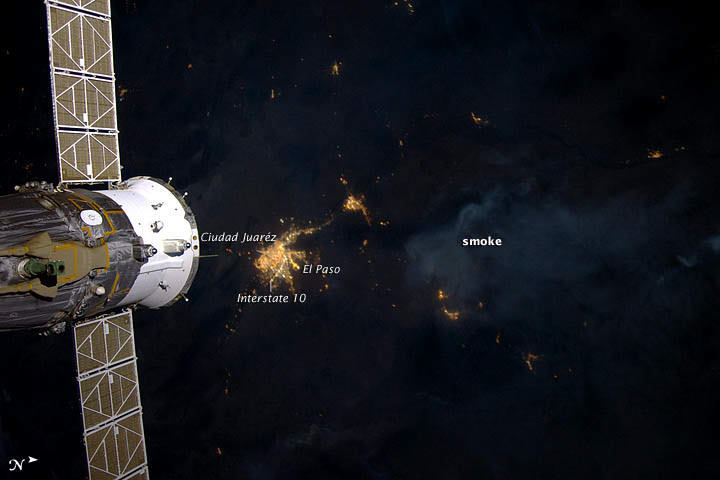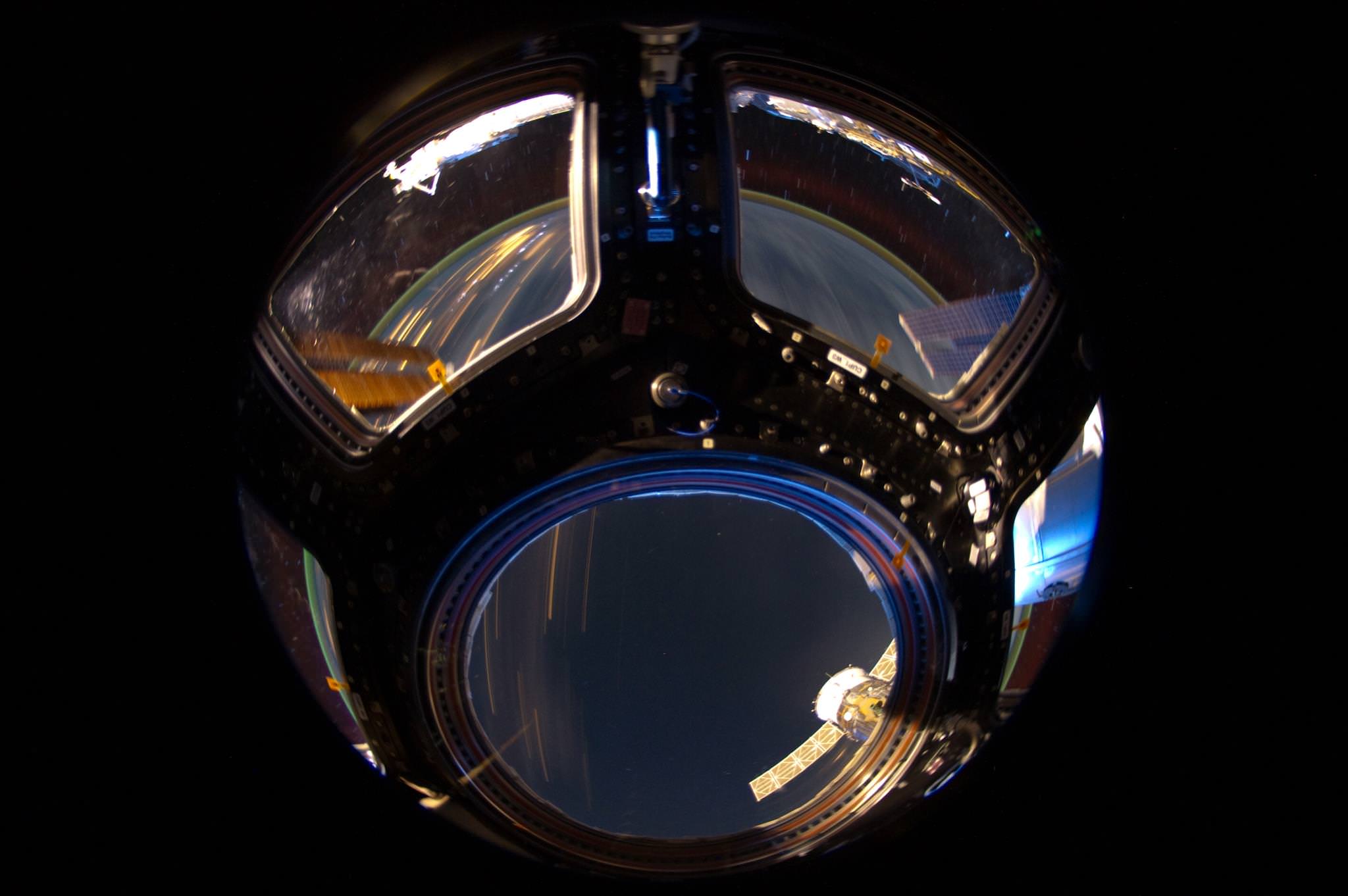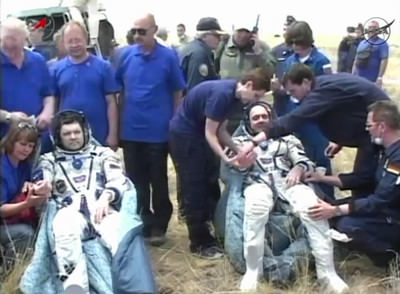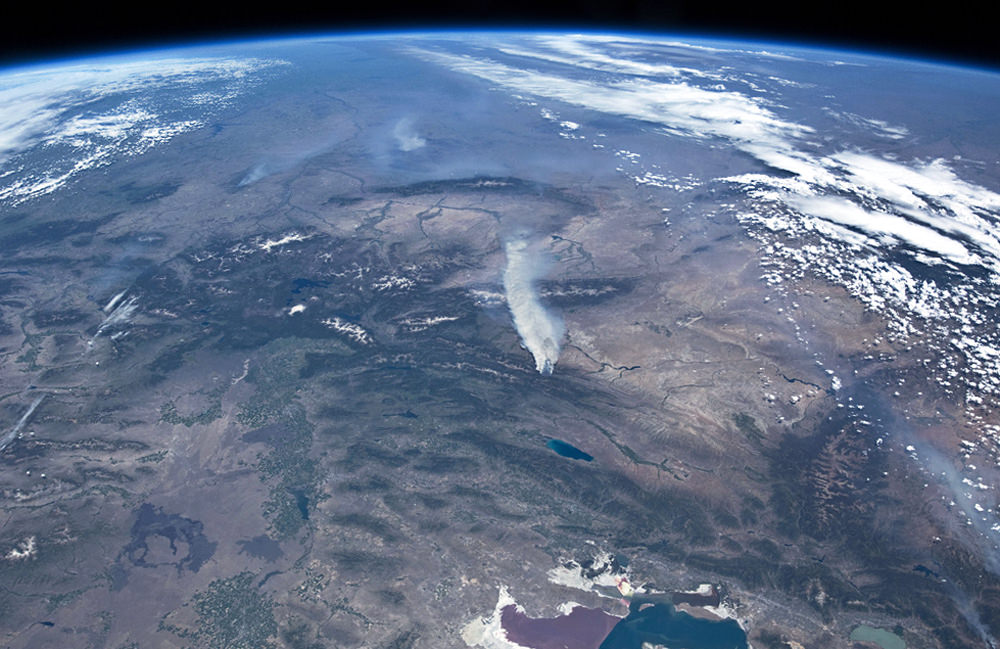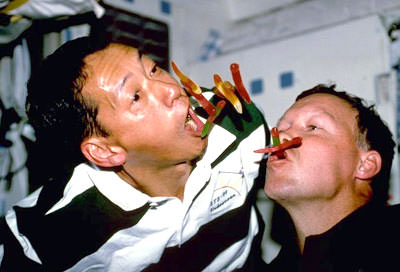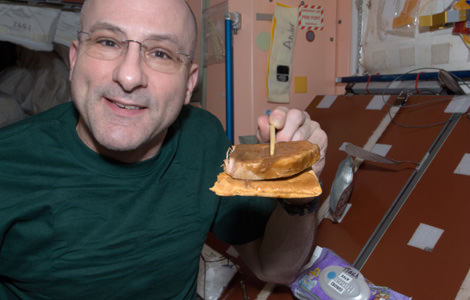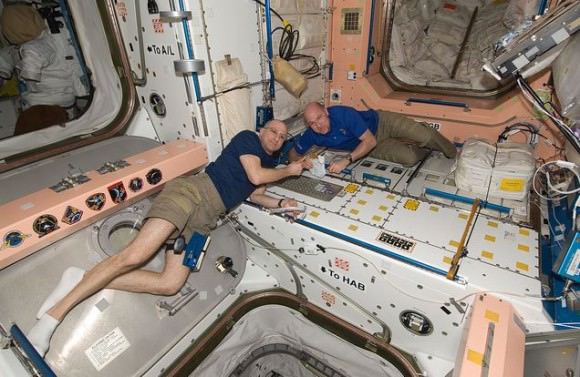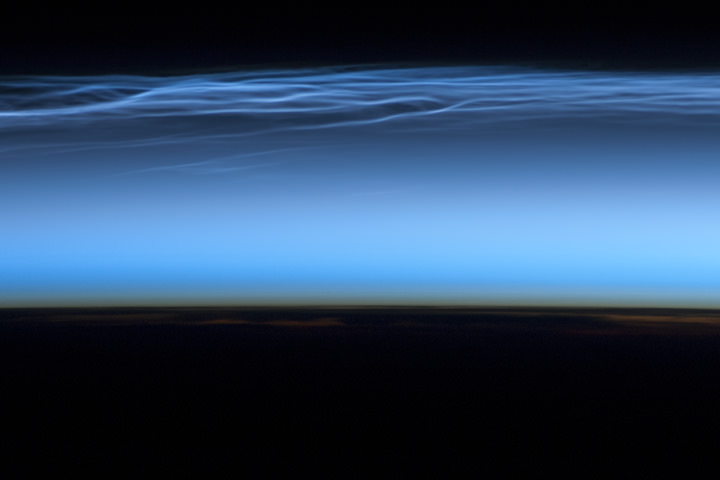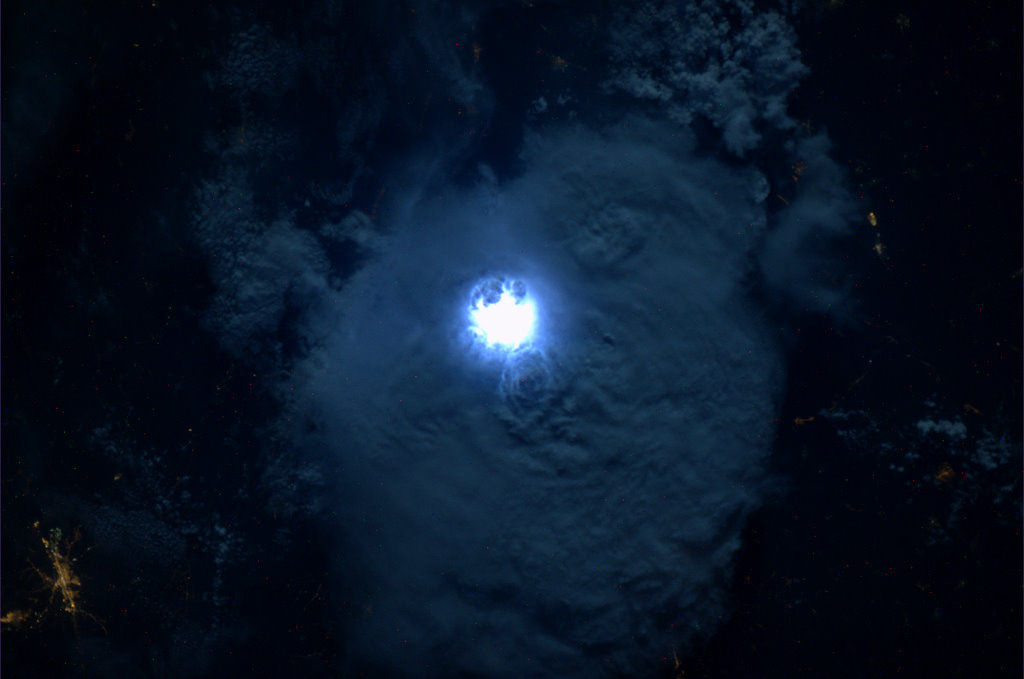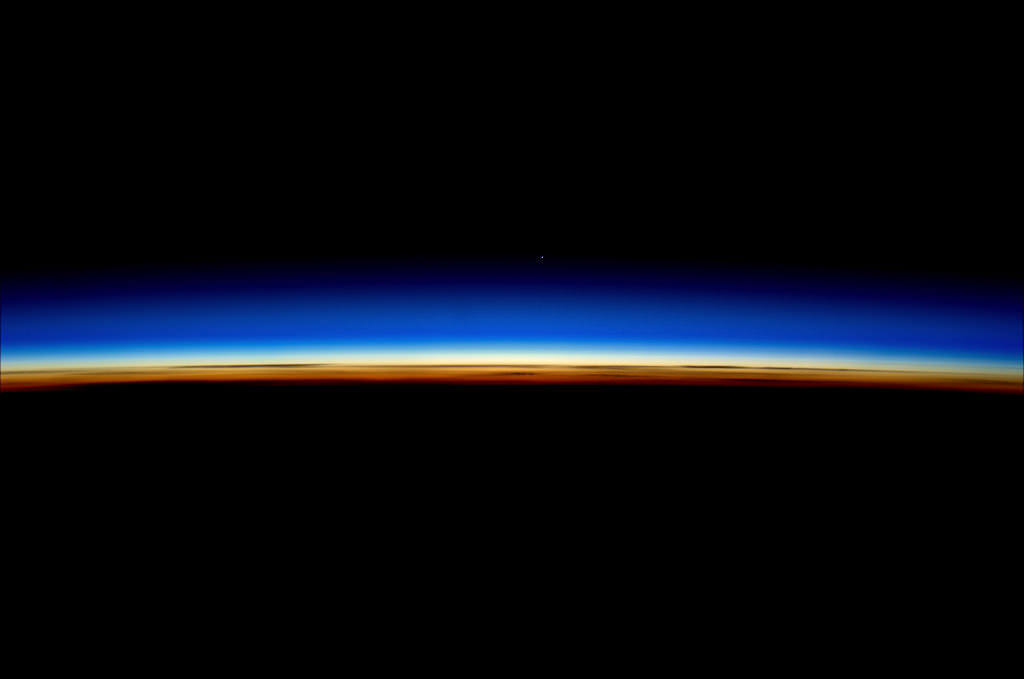The Whitewater-Baldy fire is the largest wildfire in New Mexico’s history and has charred more than 465 square miles of the Gila National Forest since it started back on May 16, 2012 after several lightning strikes in the area. This wildfire produced so much smoke that it was visible even at night to the astronaut photographers on the International Space Station. This image was taken on June 2, 2012 by the crew of Expedition 31 on the ISS, with a Nikon D3S digital camera. A Russian spacecraft docked to the station is visible on the left side of the image.
Credit: NASA Earth Observatory website.
A Sci-Fi View from the ISS
What an awesome image of the Cupola on the International Space Station, with a view of Earth whizzing by! But, is the astronaut-photographer on the outside looking in, or on the inside looking out of the Cupola? We know it is taken from the inside, with a view of the Pacific Ocean near Mexico’s Baja Peninsula, but it offers a stunning and futuristic — if not somewhat perplexing — perspective. It was captured at 04:59 GMT June 26, 2012. Credit: NASA
ISS Expedition 31 Crew Returns Safely to Earth
We’re sure going to miss Don Pettit’s and Andre Kuipers’ reports and images from the International Space Station. Pettit, Kuipers and Russian Commander Oleg Kononenko undocked from the International Space Station and returned safely to Earth on July 1, wrapping up their six-and-a-half-month mission in orbit.
They landed in their Soyuz TMA-03M spacecraft in Kazakhstan at 08:14 a.m. UT (2:14 p.m. local time) after undocking from the space station’s Rassvet module at 04:47 UT. This video shows a great view of the Soyuz slowly drifting down (it’s interesting to see the parachute undulate, looking almost like a jellyfish!) and then visible are the breaking thrusters firing just a second before the hard landing.
The trio originally arrived at the station back on Dec. 23, 2011, and during this mission spent a total of 193 days in space, 191 of which were aboard the station.
During their expedition, the crew supported more than 200 scientific investigations involving more than 400 researchers around the world. The studies ranged from integrated investigations of the human cardiovascular and immune systems to fluid, flame and robotic research. They also were part of the team that successfully berthed the first commercial spacecraft to visit the ISS, the SpaceX Dragon capsule.
Before leaving the station, Kononenko handed over command of Expedition 32 to the Russian Federal Space Agency’s Gennady Padalka, who remains aboard the station with NASA astronaut Joe Acaba and Russian cosmonaut Sergei Revin. NASA astronaut Sunita Williams, Russian cosmonaut Yuri Malenchenko and Japan Aerospace Exploration Agency astronaut Akihiko Hoshide will join them July 17. Williams, Malenchenko and Hoshide are scheduled to launch July 14 from the Baikonur Cosmodrome in Kazakhstan.
During Expedition 31, Pettit used household objects aboard the station to perform a variety of unusual physics experiments for the video series “Science Off the Sphere,” like his recent video showing water balloons in space. Through these demonstrations, Pettit showed more than a million Internet viewers how space affects scientific principles.
On June 25, Pettit reached a milestone: spending one cumulative year in space, combining his time in orbit on Expedition 6, Expedition 30/31 and the STS-126 space shuttle Endeavour flight to the station in November 2008. Pettit now has 370 days in space, placing him fourth among U.S. space fliers for the longest time in space.
Kuipers conducted over 50 scientific experiments for ESA, and shared, almost daily, images and reports of his stay in space. The next ESA astronaut to board the Space Station is Luca Parmitano of Italy, who will fly on Soyuz TMA-09M in 2013 as member of Expedition 36/37.
Smoking Wildfires Seen From Space
Wildfires continue to rage across the western United States, burning forests and property alike, and even the most remote have sent up enormous plumes of smoke that are plainly visible to astronauts aboard the Space Station.
The photo above was taken by an Expedition 31 crew member on June 27, showing thick smoke drifting northeast from the Fontenelle fire currently burning in Wyoming. More plumes can be seen to the north.
Utah’s Great Salt Lake can be seen at the bottom right of the image. Its two-tone coloration is due to different species of algae that live in the lake, which is split by the physical barrier of a railroad causeway.
You can watch a video of the wildfires in the west taken from the ISS here, and see more “fire and smoke” news and images from space here.
Image: NASA
Don Pettit’s Guide to Space Etiquette: Having Guests for Dinner
If you haven’t been reading astronaut Don Pettit’s “Letters to Earth” – a diary of his 6-month stay in space – it’s a great look at living on board the International Space Station. He talks about everything from the big events to the minutia of daily life. His latest entry about being a gracious host in space is classic Pettit: detailed, precise, with just a hint of snark. We present it in its entirety here:
It does not matter that you’ve seen the same faces every day for months on end; you’d still like to invite everyone over to “your module” for dinner. With invitations accepted, you prepare for the occasion. But what is the expected etiquette for entertaining in orbit? How do you arrange things so your guests will not think you are gauche? Here are a few space-tested guidelines to help in the preparations.
Have plenty of food, and serve your very best. Now is the time to break out those thermal-stabilized pouches of beef steak that you have been hoarding. Bring out any specialty item from your personal crew allotment (these items arrive on the periodic unmanned resupply spacecraft that visit us). Perhaps you can share a can of smoked anchovies, New Mexico green chili, or a piece of Old Amsterdam cheese. Always serve something special that is not repeatedly eaten on the standard nine-day menu. Being generous now will reap more benefits than eating these delicacies in solitude.
The choice of beverage is rather limited. You can serve the standard ones: coffee, tea, and artificially flavored, artificially colored, sugar-loaded, fruit-replica drinks. All, of course, are served in a bag, and you sip the fluid through a straw. The image of an insect sucking the juices from some lower insect may come to mind, but in space it is considered impolite to give voice to such imagery.
You can provide a special treat if you have access to one of the research refrigerators. In space, all your food is either hot or at room temperature. When you live in an isothermal environment, it can be a real treat to serve your guests a bag of cold water.
For special occasions—perhaps after a space walk or the docking of a resupply vehicle—you can serve your beverages in a “zero-g” cup. This is something you will have to make from scrap plastic sheeting (instructions are in Appendix C). These cups allow you to sip beverages from an open container, like we do on Earth. Zero-g cups, unlike bags with straws, are better for social rituals like toasting, and will bring a smile to the faces of your guests.
It is important to dress up your galley. Have full packets of wet and dry wipes within easy reach on the galley table. Take any partial packets and save them for another time. Empty the trash bins. A full trash bin is problematic; a handful of small things typically float out when new items are added. This rudely interrupts conversation while everyone scatters to collect the floating debris. It is good to have two trash bins; the standard-sized one for largish items, and an old wet wipe container for small ones. This separation of smaller trash—cutoff pouch corners, food crumbs, and wrappers—helps prevents their release when the lid is opened. Be sure to label this wet wipe container “trash”. Newly arrived crew may not be aware of this trash protocol, so it is best to politely demonstrate by example. They will learn quickly enough.
Clean the food scissors. Scissors are needed to open food pouches, as tearing them along the built-in perforations usually results in liberating hot droplets of fatty ooze and other asteroid-like particles. That’s why, if the scissors aren’t kept clean, they become caked in solidified gravy to the point where they become glued shut (not to mention being slightly repulsive). Such a state is considered rude, so clean your scissors before the guests arrive.
Always have a loaner spoon available. In weightlessness, it is easy to lose things. It is not unusual in a group of six for someone’s spoon to have floated off. Having a clean loaner spoon allows for the evening to continue and the conversation to flow. It is rude to give your guest a loaner spoon caked in crud from the last time it was used. The lost spoon is usually found by morning, stuck to a ventilator inlet screen, and your guest will appreciate it being returned.
Always put out new tape. The galley table has multiple spots of Velcro to park packets of food. However, not all packets and pouches have mating spots of Velcro, which means they can’t be set down on the table. Several strips of duct tape, carefully folded so the adhesive side is out (see Appendix D for instructions), allows such containers to be parked on the table. Tape left over from the previous week, while perfectly functional, collects errant crumbs, hairs, lint, and other unsightly things. Displaying dirty tape is exceedingly rude to your guests; always put out new, clean tape.
In space, catching food in your mouth is considered polite. Opening wide and making a clean catch will most always bring cheers from your guests. In one impressive gulp, you can leave them with the image of some sea creature inhaling another. Catching food in your mouth, like belching at the table (considered impolite in most cultures, but a compliment to the chef in others) is rude on Earth but de rigueur in space.
By following these simple rules, you will ensure a delightful evening with your guests. And remember, on the space frontier, the etiquette book is still being written. I encourage you to invent new ways of conducting everyday life, including entertaining. It is one of the reasons we find ourselves here in the first place.
Source: NASA Blogs
Image captions:
Astronauts eats gummy worms in space. Credit: NASA
Don Pettit displays his favorite snack in space. Credit: NASA
NASA astronaut Don Pettit (left) and European Space Agency astronaut Andre Kuipers, both Expedition 31 flight engineers, eat a snack in the Unity node of the International Space Station. Credit: NASA
Mysterious Noctilucent Clouds as Seen from the International Space Station
Mysterious “night shining” or noctilucent clouds are beautiful to behold, and this stunning image offers an unusual view of these clouds as seen by astronauts on board the International Space Station. Also called polar mesospheric clouds, these clouds are puzzling scientists with their recent dramatic changes. They used to be considered rare, but now the clouds are growing brighter, are seen more frequently, are visible at lower and lower latitudes than ever before, and sometimes they are even appearing during the day.
The astronauts were also able to take a time-lapse sequence of these clouds on June 5, 2012, as seen below. According to NASA, it is first such sequence of images of the phenomena taken from orbit.
The sequence in this video was taken while the ISS was passing over western Asia. By focusing on the limb of the Earth at night with the Sun illuminating it, the crew was able to capture some movement to these mysterious clouds.
There is quite a bit of debate for the cause of noctilucent clouds. Dust from meteors, global warming, and rocket exhaust have all been tagged as contributors, but the latest research suggests that changes in atmospheric gas composition or temperature has caused the clouds to become brighter over time.
Noctilucent clouds are usually seen during the summertime, appearing at sunset. They are thin, wavy ice clouds that form at very high altitudes (between 76 to 85 kilometers (47 to 53 miles) above Earth’s surface and reflect sunlight long after the Sun has dropped below the horizon. They appear in both the Northern and Southern Hemisphere and appear as delicate, shining wispy clouds against the dark sky.
The top image from the ISS was taken on June 13, 2012, as the space station passed over the Tibetan Plateau. At the same time, polar mesospheric clouds were also visible to aircraft flying over Canada. In addition to the noctilucent/polar mesospheric clouds trending across the center of the image, lower layers of the atmosphere are also illuminated. The lowest layer of the atmosphere visible in this image—the stratosphere—is indicated by dim orange and red tones near the horizon.
Lead image caption: Noctilucent or Polar Mesospheric clouds captured by the crew of the ISS on June 13, 2012. Credit: NASA
Source: NASA Earth Observatory
Lightning From Space!
[/caption]
Here’s an amazing shot of a flash of lightning within storm clouds over west Africa, captured from orbit by ESA astronaut André Kuipers aboard the ISS.
Lightning is a common sight from Space Station, creating a constant light show for the astronaut and cosmonaut crew members. On average, lightning strikes the ground somewhere on Earth 100 times each second, and there are 5 to 10 times as many cloud-to-cloud flashes as there are ground strikes. That adds up to about 40 to 80 million flashes of lightning every day around the world! Considering that the ISS orbits Earth 16 times a day — and from quite a high viewpoint — it stands to reason that lightning is spotted quite often.
So although it may not be rare, lightning still makes for dramatic photos — especially to those of us here on the ground!
For more information on André and his ongoing long-duration PromISSe mission, visit the ESA site here.
Image credit: ESA/NASA
Venus Transit As Seen from the International Space Station
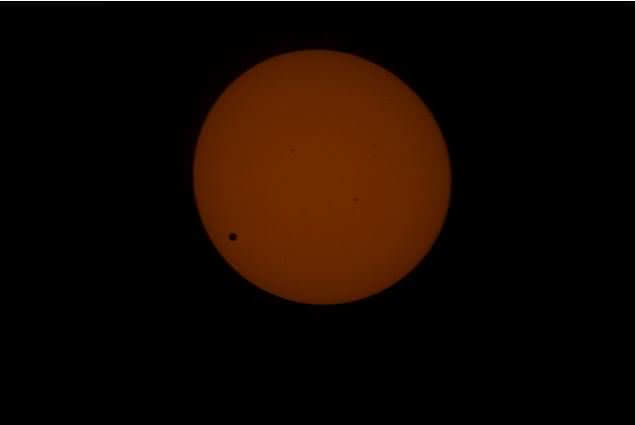
[/caption]
The guy known as Mr. Fixit in space was also Mr. Prepared. This image is from NASA Astronaut Don Pettit on board the International Space Station, who had the foresight to bring a solar filter for his camera. “I’ve been planning this for a while,” said Pettit. “I knew the Transit of Venus would occur during my rotation, so I brought a solar filter with me when my expedition left for the ISS in December 2011.”
This is his first image, and we’ll add more as they become available. Pettit is trying to download his images almost real-time. He is photographing the historic transit of Venus through the Space Station’s Cupola, removing the scratch panes on the Cupola’s windows to get crisp, clear images.
Pettit is using a high-end Nikon D2Xs camera and an 800mm lens with a full-aperture white light solar filter.
Tomorrow’s Transit Will be the First Photographed From Space
[/caption]
ESA astronaut Andre Kuipers captured this stunning image of Earth’s limb with Venus shining brightly above on the morning of June 4, 2012. While it’s a fantastic shot in its own right, it’s just a warm-up for tomorrow’s big transit event, which will be watched by millions of people all over the world — as well as a select few aboard the ISS!
While many people will be taking advantage of this last opportunity to see Venus pass across the face of the Sun — a relatively rare event that’s only happened six times since the invention of the telescope, and won’t occur again until 2117 — the crew of the International Space Station is preparing to become the first astronaut to photograph it from space!

Expedition 31 flight engineer Don Pettit knew he’d be up in orbit when this transit takes place, and he went prepared.
“I’ve been planning this for a while,” says Pettit. “I knew the Transit of Venus would occur during my rotation, so I brought a solar filter with me when my expedition left for the ISS in December 2011.”
(See more of Don Pettit’s in-orbit photography: Timelapse of a Moonrise Seen From The ISS)
Even though the 2004 transit happened while the ISS was manned, the crew then didn’t have filters through with to safely view it.
Pettit will be shooting the transit through the windows of the cupola. He’ll even be removing a scratch-resistant layer first, in order to get the sharpest, clearest images possible — only the third time that’s ever been done.
Don’s images should be — no pun intended — brilliant.
“I’ll be using a high-end Nikon D2Xs camera and an 800mm lens with a full-aperture white light solar filter,” he says.
And if you want to follow along with the transit as it’s seen from down here on Earth, be sure to tune in to Universe Today’s live broadcast on Tuesday, June 5 at 5 p.m. EDT where Fraser Cain will be hosting a marathon event along with guests Pamela Gay, Phil Plait (a.k.a. the Bad Astronomer) and more as live views are shared from around the world.
Unless you plan on being around in 2117, this will be your last chance to witness a transit of Venus!
Read more about Don Pettit’s photo op on NASA Science News here.
Dragon’s Ocean Splashdown Caps Historic Opening of New Space Era
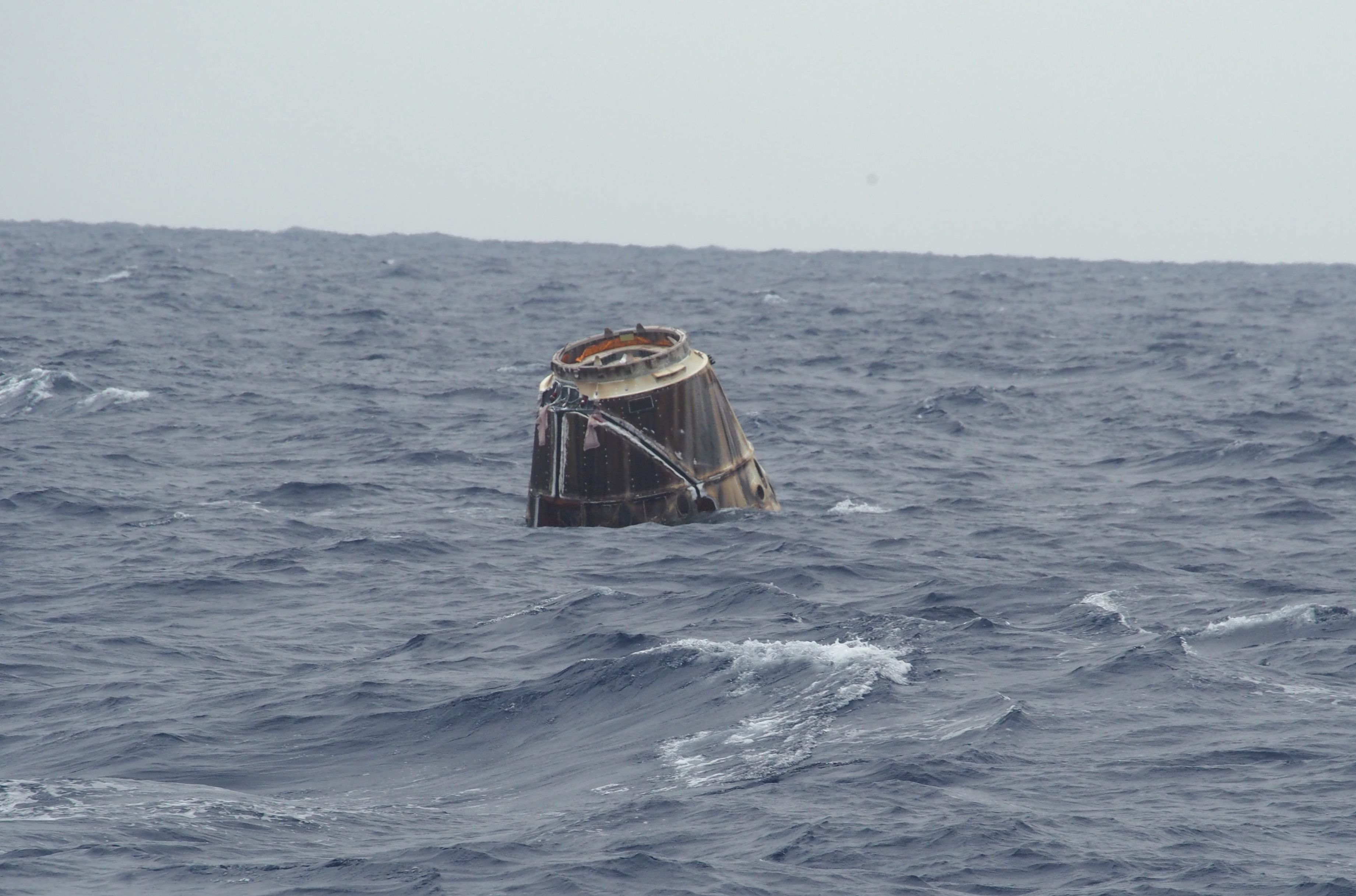
[/caption]
Concluding a perfectly executed and history making test flight, the first private spacecraft ever to visit and dock at the International Space Station (ISS) performed a picture perfect splashdown at 11:42 a.m. EDT (1542 GMT) today, May 31, in the Pacific Ocean, off the west coast of Baja, California, some 560 miles southwest of Los Angeles to cap the opening to a historic new Era in Space Exploration.
Dragon is the linchpin in NASA’s bold Commercial Crew and Cargo program aimed at significantly driving down the cost of transporting cargo and crews to low Earth orbit by using private commercial companies to foster competition and innovation in the free market setting of the new, post-shuttle Era of Commercial Space Transportation.
NASA aircraft were able to transmit live video of the last few minutes of the Dragon’s breathtaking descent, unfurling of the trio of parachutes and ocean splashdown – pretty much on target at 27 degrees latitude and 127 degrees west longitude.
The official mission elapsed time on landing was 9 days, 7 hours and 58 minutes.
Splashdown of the Dragon cargo craft took place barely 6 hours after departing the orbiting lab complex following detachment from the station using the station robotic arm. The ISS astronauts released the craft from the grip of the station’s robot arm at 5:49 a.m. EST (949 GMT) this morning, May 31.
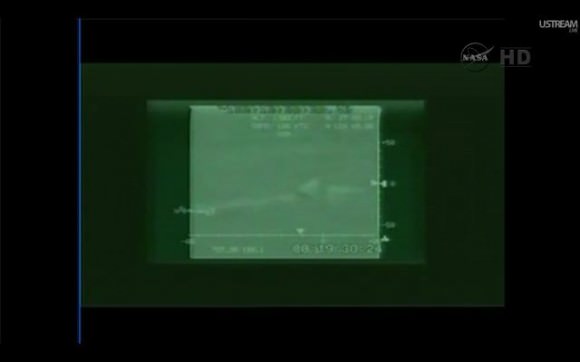
The two spacecraft were soaring some 250 miles (400 km) high above the Indian Ocean east of Africa at the moment of release and departure. Altogether, Dragon spent 5 days, 16 hours and 5 minutes mated to the station.
The gumdrop shaped Dragon capsule is 4.4 meters (14.4 ft) tall, and 3.66 m (12 ft) in diameter and has an internal pressurized volume of about 350 cubic feet .
The Dragon cargo resupply capsule was built by SpaceX and is being retrieved from the ocean by a flotilla of three recovery ships. The ships reached Dragon, detached the chutes and are in the process of recovery. It will take about two days to deliver the craft to the port of Los Angeles where the most critical cargo items will be removed for quick shipment to NASA. The capsule will then be shipped to SpaceX’s McGregor,Texas facility for post-flight evaluation.
Dragon is the world’s first commercial spacecraft whose purpose is to carry supplies to and from the ISS and partially replace the cargo capabilities previously performed by NASA’s now retired fleet of space shuttle orbiters. Dragon was designed, developed and built by Hawthorne, Calif., based SpaceX Corporation, founded in 2002 by CEO and Chief Designer Elon Musk.
“This has been a fantastic day,” said Musk at a post splashdown briefing for reporters. “I want to thank NASA and the whole SpaceX team for an amazing job.”
“I’m really proud of everyone. This really couldn’t have gone better. We’re looking forward to doing lots more missions in the future and continuing to upgrade the technology and push the frontier of space transportation.”
“In baseball terminology this would be a grand slam. I am overwhelmed with joy.”
The de-orbit burn to drop Dragon out of orbit took place precisely on time at 10:51 a.m. EDT for a change in velocity of 100 m/sec about 246 miles above the Indian Ocean directly to the south of India as the craft was some 200 miles in front of the ISS.
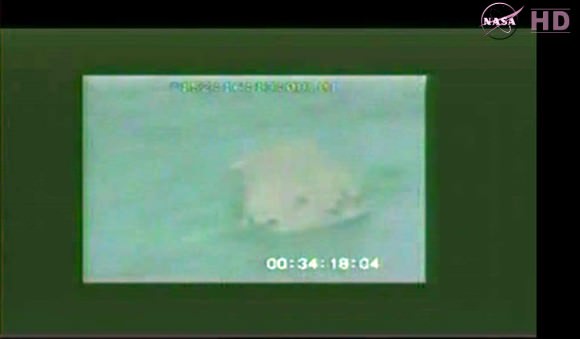
The Draco thruster firing lasted 9 minutes and 50 seconds and sent Dragon plummeting through the Earth’s atmosphere where it had to survive extreme temperatures exceeding 3000 degrees F (1600 degrees C) before landing.
The Dragon capsule is the first US vehicle of any kind to arrive at the ISS since the July 2011 forced retirement of NASA’s Space Shuttle Program resulted in the total loss of all US capability to send cargo and humans crews to the massive orbiting outpost.
SpaceX signed a contract with NASA in 2006 to conduct twelve Falcon 9/Dragon resupply missions to carry about 44,000 pounds of cargo to the ISS at a cost of some $1.6 Billion over the next few years.
This was the third test flight of the Falcon 9 rocket and the first test flight of the Dragon in this vastly upgraded configuration with solar panels. A future variant of Dragon will eventually blast US astronauts to space and restore US crew capability – perhaps by 2017 thanks to repeated cuts to NASA’s budget.
Only four entities have ever sent a spacecraft to dock at the ISS – the United States, Russia, Japan and the European Union. SpaceX is the first commercial entity to accomplish the same feat.
The precedent setting Dragon mission has opened a new era in spaceflight by giving birth to the first fully commercial mission to the orbiting space station complex and unlocking vast new possibilities for its utilization in science and exploration.
On May 22, Dragon thundered to orbit atop a SpaceX built Falcon 9 rocket during a pre-dawn liftoff at 3:44 a.m. EDT from Space Launch Complex-40 on Cape Canaveral Air Force Station, Florida.
After a three day chase, Dragon arrived at the ISS on May 25 and was deftly berthed at an open Earth-facing port on the Harmony Node 2 module after being dramatically captured by the astronaut crew using the station’s robotic arm in a landmark event in space history as the Dragon and the ISS were passing about 251 miles above Earth. Capture was confirmed at a mission elapsed time of 3 days, 6 hours and 11 minutes and 23 seconds.
Working in tandem, NASA astronaut Don Pettit and ESA astronaut Andre Kuipers snared the Dragon craft as it was drifting in free space about 10 m (32 ft) away with the 18 m (58 ft) long Canadian robot arm at 9:56 a.m. EDT and parked the first privately built capsule to an open port at 12:02 p.m. EDT on May 25.
The astronauts opened the hatch and ‘Entered the Dragon’ for the first time a day later on May 26 and then proceeded to unload the stowed cargo and refill it for the return trip to Earth.
On this first NASA sponsored Dragon test flight to rendezvous and dock at the ISS, the cargo craft was packed with 460 kilograms (1014 lbs) of non-critical cargo including 306 kg (674 lbs) of food and crew provisions; 21 kg (46 lbs) of science experiment; 123 kg (271 lbs) prepositioned cargo bags to be used for future flights; and 10 kg (22 lbs) of assorted computer supplies and a laptop.
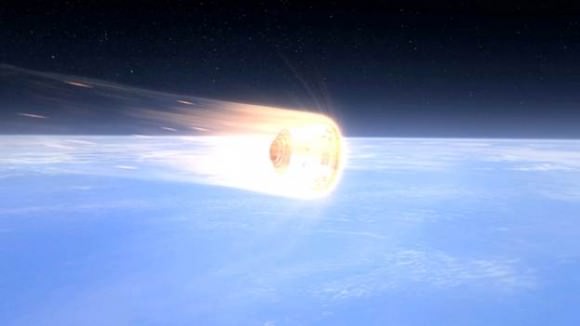
Unlike the other Russian, European and Japanese cargo freighters that service the ISS and then disintegrate on reentry, the SpaceX Dragon is uniquely equipped with a state of the art PICA-X heat shield that allows it to plunge safely through the Earth’s atmosphere and survive the fiery temperatures exceeding more than 3000 degrees F (1600 degrees C).
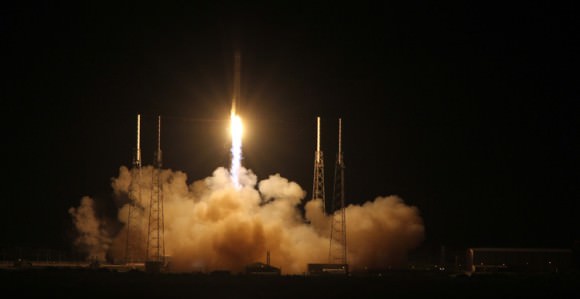
The down mass capability restores another critical capability lost with the forced retirement of NASA’s Space Shuttle orbiters in July 2011. The astronauts filled Dragon with about 620 kilograms (1367 pounds) of science experiments, trash and non-critical items on this historic test flight.
The first operational Dragon resupply mission to the ISS could blast off as early as September, said Alan Lindenmoyer, manager of NASA’s Commercial Crew and Cargo Program.
“We’ll await the final post flight report to make the determination that this was an extremely successful mission. But they should be well on their way to starting [delivery] services,” said Lindenmoyer at the briefing. “Of course, officially we will look at the post flight data and make an official determination. But I would say at this point it looks like 100 percent success.”

